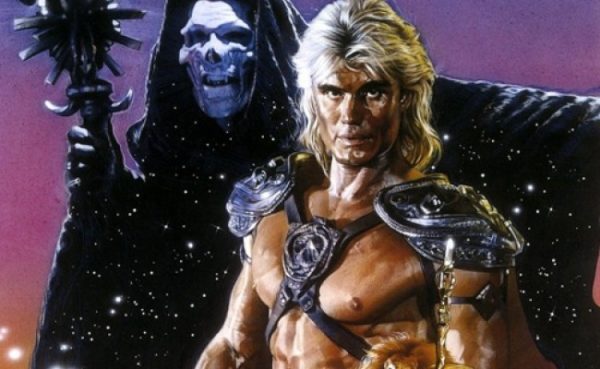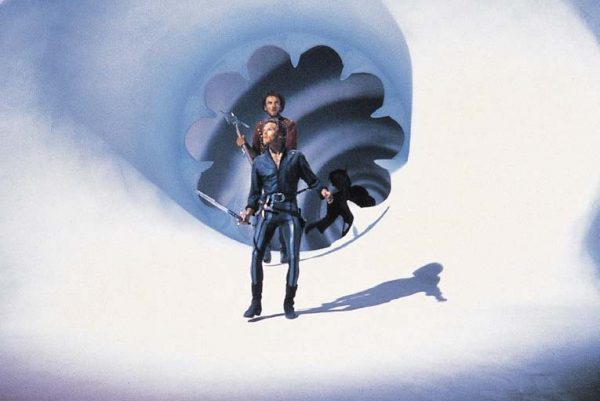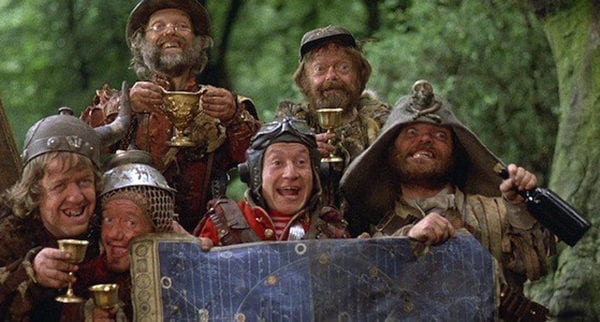Tom Jolliffe takes a jaunt back to the 80s to see how some of the decade’s biggest fantasy films have aged…

Growing up as a young sprog in the 80’s I was treated to all manner of eye-catching fantasy films. A lot of these ‘kids’ films were completely savaged by critics at the time. I grew up idolising He-Man and believing that the film adaptation starring Dolph Lundgren and Frank Langella was the greatest film ever made. Now of course I was obviously right but grown-ups (critics in particular) felt quite the opposite. Now in retrospect, it might not be high art, and all the behind the scenes issues that manifest themselves into the film are clear, but time in some regards, has been kind to Masters of the Universe.
It doesn’t take itself too seriously on the whole. It’s cheesy, it’s fun. There are gags. It’s more intentionally funny than people might remember (if you’ve ever attended a big screen showing you’ll appreciate the reaction). It’s also still unintentionally goofy in places too (big screen showings again…). What you might also notice, is that the film bears striking formula relations to the MCU. Not as perfected mind you, but it’s got its charms, not least a villain so intensely, brilliantly, Shakespearean-ly played by Frank Langella, that it makes that side of the film special.

So here’s the rub. A genre back in the 80’s that would almost perennially be looked upon scornfully has had a post-millennium turnaround. Now fantasy and comic book heroics lead the way on the big screen. Blockbusters have almost completely washed away everything else. There have been a lot of 80’S kids fantasy films treated to a re-evaluation over the years. Now of course Star Wars hit big and hit hard. It even wooed a few critics (and likewise those first two sequels) but many that followed in its wake have only more recently found love.
I recently re-watched Krull. This is a great example. Critics demolished it. They ‘glaved’ the f**k outta Krull. It didn’t particularly click with audiences either, and like a lot of fantasy films of the era…here’s why; Grown up film-makers with a lineage of mature, adult films, often coming with a CV boasting late 60’s, early 70’s pessimistic drama/thrillers, were finding themselves making kids films. Plotlines got deep, dark sometimes (not particularly in Krull I might add). Film’s were often given particularly dark moments or scary creatures, or downright traumatic moments (the swamp of sadness in The Neverending Story). There was this odd conflict between wanting to make a kids film and still maintaining maturity. Krull struggled with that balance back then, but now the whole thing seems to sit better in the modern era. Further, with the current demand for comic heroes, wizards and whatever, utterly daft ideas are more routinely accepted. Directors like Krull’s Pete Yates, or Mike Hodges (Flash Gordon), Ridley Scott (Legend), Wolfgang Petersen (Neverending Story) came from a lineage of making Bullit, Get Carter, Alien/Blade Runner and Das Boot respectively.

For a film like Krull say, you can finally appreciate that the story and characters, for the genre, are engaging enough, but then you can throw in strong direction from Peter Yates, exquisite cinematography by Peter Suschitzky (Empire Strikes Back), amazing music by James Horner (see also Willow for another rousing fantasy score from the late great Horner), a special make-up team that included Bob Keen no less. It has awesome sets and great visual effects because basically, Krull was the epitome of cherry picked big budget film-making of the time (‘He worked on Superman? Get him in!’). With the crew involved it was only ever going to look exceptional, and in an era where you didn’t just shoot in a large green room and crafted your lighting in post. They shot in large studio sets (Pinewood), lit those sets and embellished with great matte work where needed. Daft as some aspects may be, with hokum in spades, hokum is in vogue now and the cast have the requisite sincerity to sell it (including Alun Armstrong, Liam Neeson, Robbie Coltrane among others).
Another film I revisited was The Neverending Story. This doesn’t quite have the same battle against instincts as Krull generally, nor something like Ridley Scott’s Legend for example, but The Neverending Story has enough wondrous magic to entertain myself now, and transfix my young daughter. It’s exciting, engaging and campy enough with big eyed creatures to entice the young. Generally scary enough to have the youngens awed but not driven to nightmare, even if the aforementioned Swamp of Sadness is still a harrowing scene. The film also rather skilfully, more than it may have initially been given credit for deals with real issues and how a feeling of depression, isolation or hopelessness can so easily consume. It deals with dealing with this, and with repression and it gives us a really complex protagonist for one so young. Bastien, still raw with the loss of his mother and dealing with bullying and the folly of his youth being slowly driven from him by adults is a brilliantly written character. You’ve still got all the silliness, the campy effects, but there’s some depth. You can indeed look also at Labyrinth which has been hidden oubliettes of psychological insight with its protagonist.

It may generally be that cinema has dumbed down this century too. Films seen as somehow insightful and clever, aren’t particularly (or at least didn’t do anything we’ve not seen). Joker for example seems to be deified among younger audiences as being intelligent and masterful in its portrayal. Whilst it’s got more meat to it than most modern films of its ilk, it still lacks any kind of subtlety in its portrayal. It’s all hammered home forcefully. I sometimes think, ‘kid…go and watch Taxi Driver, please.’ Maybe they’re just safer these days. Blockbusters in general I suppose. Ask Blade Runner 2049 if complexity sells. It doesn’t. Likewise I can’t see too many films so beautifully and complexly crafting young characters like The Neverending Story, or Labyrinth. Something ingrained in the film-makers and writers challenged the genre they were writing and injected a depth that in many cases might have contributed to those films bombing at the box office.
With Time Bandits for example, Terry Gilliam approaches the film in his uniquely Gilliam way. He makes a wry and biting satire within a kids film, loading it with Python-esque humour, a protagonist group of unsympathetic bandits (including Kenny ‘R2D2’ Baker) and wonderfully imaginative visuals. There is an inherent strength to go against the grain, to be creative, to make a film that audiences may rebel against, and somehow or another, having the studio greenlight it (because Gilliam has almost always battled). These days of course, big budget high profile film-makers have found themselves bombed out of productions for going too much against the grain.

There are so many 80’s fantasy films that, for the sheer imagination are to be admired. Some still don’t work, like Legend. A very childish story is hammered together with visuals right out of a gruesome horror film. It’s still an awe-inspiring watch on an aesthetic basis, even if the dialogue is groan-worthy. Gilliam would also follow the brilliant Bandits with the double-down, uber Gilliam offering, The Adventures of Baron Münchhausen. What it might lack in consistency, it makes up for in visual splendour, great casting and humour, even if Gilliam’s snipe at consumerism in Bandits gives that film an edge.
Many of these films hold up better now than ever, whether for simple fun or for their hidden depths. What are your favourite fantasy films from the 80’s? Have they aged well? Let us know on our social channels @flickeringmyth…
Tom Jolliffe is an award winning screenwriter and passionate cinephile. He has a number of films out on DVD/VOD around the world and several releases due out in 2021/2022, including, Renegades (Lee Majors, Danny Trejo, Michael Pare, Tiny Lister, Nick Moran, Patsy Kensit, Ian Ogilvy and Billy Murray), Crackdown, When Darkness Falls and War of The Worlds: The Attack (Vincent Regan). Find more info at the best personal site you’ll ever see here.










